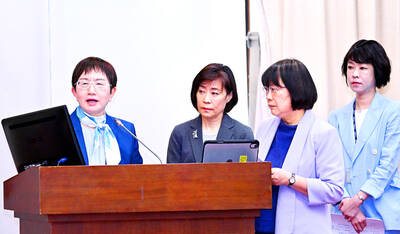Win Semiconductors Corp (穩懋) on Thursday said its revenue for last month was its highest ever thanks to bullish demand for its vertical-cavity surface-emitting laser (VCSEL) components.
Semiconductor-based laser diodes, which are a major lighting source for 3D sensing, make up the components.
Believed to be one of Apple Inc’s primary suppliers for its iPhone X TrueDepth front-facing camera system, California-based Lumentum Holdings Inc is one of the Linkou (林口), Taoyuan County-based company’s clients.
Along with stable contribution from radio frequency (RF)-related products, consolidated revenue last month increased 2.58 percent month-on-month to NT$1.94 billion (US$65.71 million), up 79.6 percent from a year earlier, Win Semiconductors said in a statement.
The company is the world’s leading gallium arsenide (GaAs) wafer foundry services provider for RF chips and monolithic microwave chips.
Its main products include power amplifier (PA) chips, Wi-Fi-linked components and applications related to infrastructure, such as those for base stations, optical fiber networks, satellite communications and national defense.
The company’s revenue and gross margin would likely benefit from a multi-year 3D sensing demand, given a higher 3D sensing adoption by Android-based smartphones and a better margin prospect after flattening of the learning curve, analysts said.
“We expect Win Semi’s 3D sensing revenue to grow on Android smartphones’ adoption and key smartphone customer new models in 2018, and wider adoption into gaming console, AR/VR devices, and security systems in the mid to long-term,” Macquarie Capital Ltd said in a note on Dec. 1. “Win Semi’s leading technology, mass production track record, and close collaboration with key customers should keep it in leading position in the market.”
The company’s local peers — Advanced Wireless Semiconductor Co (宏捷) and Visual Photonics Epitaxy Co (全新), one of the top three GaAs epitaxial wafer manufacturers in the world — also reported better-than-expected sales for last month.
Advanced Wireless Semiconductor registered revenue last month of NT$140 million, its highest in six months, a 18.94 percent increase month-on-month and 0.36 percent year-on-year.
Visual Photonics posted NT$195 million in revenue, down 2.83 percent from November, but up 56.18 percent from December 2016.
The three firms are considered to be among the major “Apple concept stocks” in Taiwan and are expected to report strong sales this quarter, considering the growing demand for VCSEL components and the deployment of 5G infrastructure, analysts said.
Win Semiconductors reported earnings of NT$17.06 billion for the whole of last year, up 25.38 percent from 2016; Visual Photonics’revenue totaled NT$2.14 billion, representing an annual fall of 2.09 percent; while Advanced Wireless Semiconductor’s sales during the same period decreased 26.9 percent year-on-year to NT$1.66 billion.
In Taipei trading on Friday, Win Semiconductors shares declined 0.16 percent to close at NT$303, while Advanced Wireless Semiconductor shares rose 0.55 percent at NT$73.6 and Visual Photonics shares increased 1.12 percent to NT$99, Taiwan Stock Exchange data showed.

‘SWASTICAR’: Tesla CEO Elon Musk’s close association with Donald Trump has prompted opponents to brand him a ‘Nazi’ and resulted in a dramatic drop in sales Demonstrators descended on Tesla Inc dealerships across the US, and in Europe and Canada on Saturday to protest company chief Elon Musk, who has amassed extraordinary power as a top adviser to US President Donald Trump. Waving signs with messages such as “Musk is stealing our money” and “Reclaim our country,” the protests largely took place peacefully following fiery episodes of vandalism on Tesla vehicles, dealerships and other facilities in recent weeks that US officials have denounced as terrorism. Hundreds rallied on Saturday outside the Tesla dealership in Manhattan. Some blasted Musk, the world’s richest man, while others demanded the shuttering of his

Taiwan’s official purchasing managers’ index (PMI) last month rose 0.2 percentage points to 54.2, in a second consecutive month of expansion, thanks to front-loading demand intended to avoid potential US tariff hikes, the Chung-Hua Institution for Economic Research (CIER, 中華經濟研究院) said yesterday. While short-term demand appeared robust, uncertainties rose due to US President Donald Trump’s unpredictable trade policy, CIER president Lien Hsien-ming (連賢明) told a news conference in Taipei. Taiwan’s economy this year would be characterized by high-level fluctuations and the volatility would be wilder than most expect, Lien said Demand for electronics, particularly semiconductors, continues to benefit from US technology giants’ effort

ADVERSARIES: The new list includes 11 entities in China and one in Taiwan, which is a local branch of Chinese cloud computing firm Inspur Group The US added dozens of entities to a trade blacklist on Tuesday, the US Department of Commerce said, in part to disrupt Beijing’s artificial intelligence (AI) and advanced computing capabilities. The action affects 80 entities from countries including China, the United Arab Emirates and Iran, with the commerce department citing their “activities contrary to US national security and foreign policy.” Those added to the “entity list” are restricted from obtaining US items and technologies without government authorization. “We will not allow adversaries to exploit American technology to bolster their own militaries and threaten American lives,” US Secretary of Commerce Howard Lutnick said. The entities

Minister of Finance Chuang Tsui-yun (莊翠雲) yesterday told lawmakers that she “would not speculate,” but a “response plan” has been prepared in case Taiwan is targeted by US President Donald Trump’s reciprocal tariffs, which are to be announced on Wednesday next week. The Trump administration, including US Secretary of the Treasury Scott Bessent, has said that much of the proposed reciprocal tariffs would focus on the 15 countries that have the highest trade surpluses with the US. Bessent has referred to those countries as the “dirty 15,” but has not named them. Last year, Taiwan’s US$73.9 billion trade surplus with the US